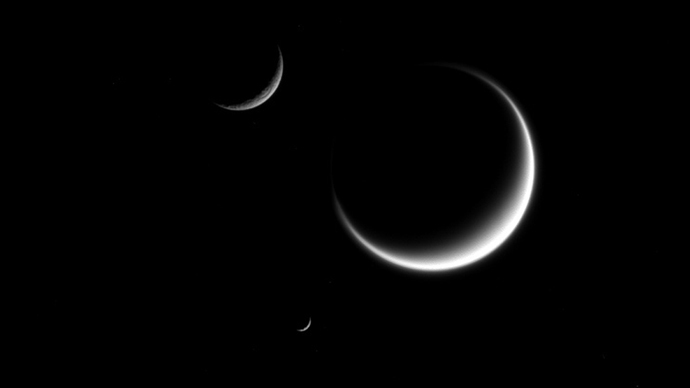Rare triple crescent moons orbiting Saturn caught by Cassini probe

The Cassini spacecraft captured a stunning image of three crescent moons orbiting the planet Saturn. It managed to photograph Titan, Mimas and Rhea all in the same shot.
Saturn has in the region of 50 moons and the NASA spacecraft managed to photograph three of them together. Titan, the largest moon in the image, appears to be fuzzy because only its cloudy outer layers are visible. Reah, which is in the upper left of the image, appears to have a rough surface due to the many craters on its icy exterior.
A single crescent moon is familiar in Earth's sky, but Saturn has many moons: http://t.co/xXDf2UAc3R@CassiniSaturnpic.twitter.com/0DqqMpxAGT
— NASA (@NASA) June 22, 2015
The smallest of the moons in the picture, Mimas, which has a surface area slightly smaller than Spain, also has a rough surface, which is mainly to do with a giant crater Herschel.
The image was taken on March 25 and was obtained from a distance of roughly 1.2 million miles (2 million km). The Cassini mission is a joint project between NASA, ESA (The European Space Agency) and the Italian Space Agency.
How did Titan's mysterious lakes form? A new study suggests processes similar to Earth's. http://t.co/PWeMvKDDDBpic.twitter.com/bqZfjrVlAU
— CassiniSaturn (@CassiniSaturn) June 19, 2015
Titan is the only body in our solar system, apart from Earth, which is known to possess seas and lakes on its surface. However, with temperatures as low as minus 292 degrees Fahrenheit (-180 Celsius), liquid methane and ethane are prevalent, rather than water.
Cassini has, however, revealed the possibility that liquid water may exist under the moon's icy shell.
READ MORE: NASA considers sending quadcopter drone to look for life on Titan
NASA are intrigued by the moon and there is even talk that they could send a drone to Titan to try and learn more about it and see if it can support life.
The ambitious idea was outlined by Larry Matthies, a research scientist and supervisor at NASA’s Jet Propulsion Lab in California, and involves a drone that would be capable of flying out of a lander or balloon. The drone would explore Titan’s landscape and seas, collect samples, and return to the “mothership” in order to recharge its batteries and submit whatever it collects for analysis.
If successful, the new plan could drastically change the way humans explore space. Current rovers on Mars are akin to moving laboratories, but their grounded nature means they can be rather limited when it comes to exploring terrain. The 22lb (10kg) drone conceived by Matthies would eliminate that barrier with flight capability, allegedly at much lower costs than other options.












